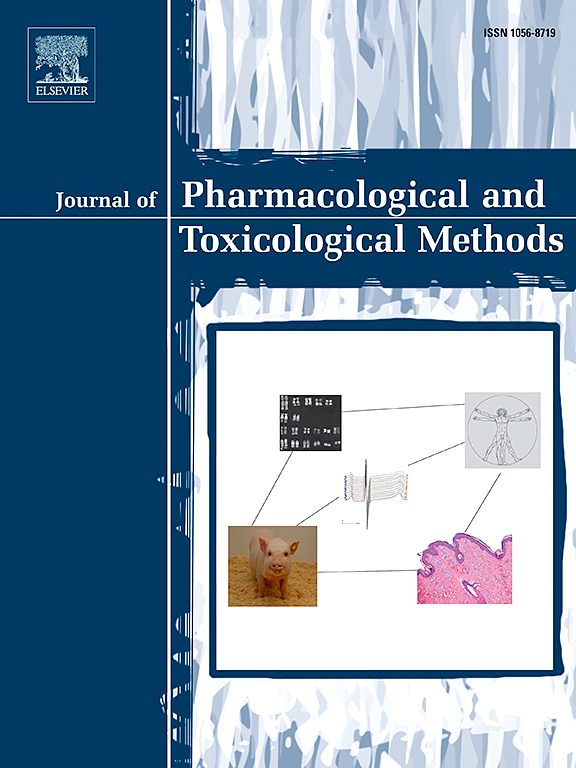用3D心脏芯片平台预测人类心脏QT间期改变和化合物的促心律失常作用
IF 1.3
4区 医学
Q4 PHARMACOLOGY & PHARMACY
Journal of pharmacological and toxicological methods
Pub Date : 2025-05-01
DOI:10.1016/j.vascn.2025.107628
引用次数: 0
摘要
在药物开发过程的早期阶段检测心脏QT间期改变和化合物的促心律失常作用仍然至关重要。因此,开发类似人类心脏的相关体外临床前模型,从而有效地预测人类复极风险是非常值得期待的。在这里,我们描述了一个在跳动的器官芯片(OoC)平台上开发的人类功能3D心脏模型,该模型集成了用于检测临床前阶段药物引起的电生理改变的适合目的的分析。该模型名为uHeart,是根据最新的国际人用药品技术要求协调委员会S7B指南开发并通过功能性心脏毒性筛查的。uHeart平台包含两项专利技术:i)通过提供生理单轴循环应变(即10 %拉伸,1 Hz)机械训练微组织的驱动机制;ii)能够读取心脏电生理信号的集成电极系统(即场电位FP)。将人诱导多能干细胞来源的心肌细胞(h-iPSC-CMs, iCell)和人真皮成纤维细胞(h-DF),比例为75 % -25 %,包埋在纤维蛋白水凝胶(125*10^6个细胞/ml)中,培养10 天。在实现功能微组织同步自发跳动后,选择体外综合心律失常测定(Comprehensive in vitro prorhymia Assay, CiPA)中列出的11种影响单或多心脏离子通道的药物来对模型进行资格验证。通过分析FP形态(即跳动周期- bp,峰值振幅- amp, FP-持续时间- fpd)和心律失常事件的发生,以增加剂量评估药物引起的改变。DMSO和阿司匹林分别作为对照和阴性对照。微组织在5 天后同步跳动,FP信号表现出典型的去极化和再极化尖峰。Ikr阻滞剂(如多非利特、奎尼丁)在浓度接近Cmax时延长FPD。ICaL阻滞剂(如维拉帕米,硝苯地平)分别将其缩短为5和50 nM。阻断INa的美西汀在10 μM处统计学上降低AMP。特非那定和多非利特均可引起心律失常事件,符合FDA标签适应症。总体而言,该系统检测FPD延长的灵敏度为83.3 %,特异性为100 %,准确性为91.6 %。DMSO(高达0.5 % w/v)和阿司匹林(高达100 μM)对复极化时间无统计学影响。uHeart生成功能性3D心脏体外模型,预测化合物在接近Cmax浓度时的特异性毒性作用,从而适合进行功能性心脏毒性临床前药物筛选。本文章由计算机程序翻译,如有差异,请以英文原文为准。
Predicting human cardiac QT alterations and pro-arrhythmic effects of compounds with a 3D beating heart-on-chip platform
Detecting cardiac QT alterations and pro-arrhythmic effects of compounds during early stages of drug development process is still critical. Hence the development of relevant in-vitro preclinical models resembling the human heart is highly envisioned, so to effectively predict repolarization risks in humans. Here we described a human functional 3D cardiac model developed within a beating Organ-on-Chip (OoC) platform integrating fit-to-purpose assays for detecting drug-induced electrophysiological alterations in pre-clinical stages. The model, named uHeart, was developed and qualified for functional cardiotoxicity screening by following the latest International Council for Harmonization of Technical Requirements for Pharmaceuticals for Human Use S7B guidelines. uHeart platform encompasses two patented technologies: i) an actuating mechanism that mechanically trains microtissues by providing a physiological uniaxial cyclic strain (i.e., 10 % stretching, 1 Hz) and ii) a system of integrated electrodes able to read electrophysiological cardiac signals (i.e., Field Potential FP). Human induced pluripotent stem cell derived cardiomyocytes (h-iPSC-CMs, iCell) and human dermal fibroblasts (h-DF), 75 %–25 % ratio, were embedded in fibrin hydrogel (125*10^6 cells/ml) and cultured for up to 10 days. Upon achievement of functional microtissues synchronously and spontaneously beating, 11 drugs listed in the Comprehensive in vitro Proarrhytmia Assay (CiPA) and affecting single or multiple cardiac ion-channels were selected to qualify the model. Drug-induced alterations were evaluated at incremental doses and by analyzing the FP morphology (i.e., beating period-BP, spike amplitude-AMP, FP-duration-FPD) and the onset of arrhythmic events. DMSO and Aspirin were used as vehicle and negative controls, respectively. Microtissues beat synchronously after 5 days, and FP signals showed the typical depolarization and re-polarization spikes. Ikr blockers (e.g., Dofetilide, Quinidine) prolonged the FPD at concentration near the Cmax. ICaL blockers (e.g., Verapamil, Nifedipine) shortened it at 5 and 50 nM respectively. Mexiletine, blocking INa, statistically decreased the AMP at 10 μM. Both Terfenadine and Dofetilide elicited arrhythmic events, matching FDA labels indications. Overall, the system showed 83.3 % sensitivity, 100 % specificity and 91.6 % accuracy in detecting FPD prolongation. DMSO (up to 0.5 % w/v) and Aspirin (up to 100 μM) did not statistically alter the repolarization time. uHeart generates functional 3D cardiac in-vitro models, predicting compound specific toxic effects at concentrations near the Cmax, thus resulting suitable to perform functional cardiotoxicity preclinical drug screening.
求助全文
通过发布文献求助,成功后即可免费获取论文全文。
去求助
来源期刊

Journal of pharmacological and toxicological methods
PHARMACOLOGY & PHARMACY-TOXICOLOGY
CiteScore
3.60
自引率
10.50%
发文量
56
审稿时长
26 days
期刊介绍:
Journal of Pharmacological and Toxicological Methods publishes original articles on current methods of investigation used in pharmacology and toxicology. Pharmacology and toxicology are defined in the broadest sense, referring to actions of drugs and chemicals on all living systems. With its international editorial board and noted contributors, Journal of Pharmacological and Toxicological Methods is the leading journal devoted exclusively to experimental procedures used by pharmacologists and toxicologists.
 求助内容:
求助内容: 应助结果提醒方式:
应助结果提醒方式:


